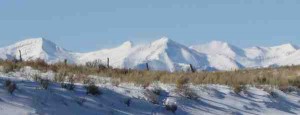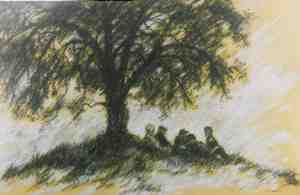Article by Lynda La Rocca
Winter – February 2008 – Colorado Central Magazine
BABY, IT’S COLD — and snowy — outside. And the snow just keeps coming. Thanks to my husband Steve, a.k.a. Mister Weather-Statistics Answer-Man, I can accurately report that here in the village of Twin Lakes, we’ve received a whopping five feet of the white stuff from December 1 through January 11. We’ve been snowed in several times, and we’d probably still be housebound if not for some very kind neighbors with advanced snow-plowing skills.
Steve and I have lived in the Upper Arkansas River Valley since 1982 and we’ve never seen such a snowy winter here before — although when I marvel (and whine) about the weather to real Leadville and Lake County old-timers, they simply shrug and snort, “This is the kind of winter we always used to have.”
Like that’s supposed to make me feel better. Meanwhile, since temperatures on 29 of the last 42 days never made it above freezing (the lowest dip was -20 degrees F.), we’ve been firing up the woodstove in the kitchen on a regular basis.
I’m talking one of those big, old four-lid cook stoves with the heavy-gauge sheet-metal exterior painted in shades of beige and pink that would make Martha Stewart cringe. It’s amazing how toasty and cozy this stove keeps the place. Still, during our six years here, I’d thought of it only as a means of warmth — until this winter.
Coming from New Jersey, my experience cooking on a wood-burning stove has been limited, to put it mildly. As much as I enjoy cooking, I’d frankly always been intimidated by this behemoth, convinced that any attempt to ply my culinary skills on, or in, it would incinerate both food and house.
But finally my curiosity, coupled with the bad weather and a nasty cold that kept me cooped up inside and looking for something to do besides cough, got the best of me. I had to find out what it’s like to cook and bake “the old-fashioned way.” So I mixed enough ingredients for two loaves of pumpkin-walnut bread. Only then did I notice that the oven thermometer on the front of this Copper-Clad Malleable Range Company stove is stuck at 500 degrees (“very hot,” the dial helpfully notes).
No working oven thermometer? No problem. I’m one of those cooks who likes to toss a dash of this or a sprinkling of that into many dishes, sometimes ignoring recipes completely and combining my own ingredients just to see what happens. Cooking without knowing what temperature I’m cooking at can’t be that much different from working without a recipe, I told myself (some would say irrationally). It’s all a matter of improvising. So, I immediately developed my own three-step method to check for doneness: 1) Obsessively peek inside the oven; 2) Periodically remove the loaves to eyeball them; 3) Relentlessly plunge toothpicks into the centers until satisfied that the contents of the baking dishes are no longer blobs of nut-studded dough.
IT WORKED! And while the holes pocking the surface marred the loaves’appearance, they still tasted good. That’s all it took to get me as fired up as the stove. What to make next? I settled on corn bread, partially because I could employ my same tried-and-true method of checking for doneness. The first pan wasn’t just delicious, if I do say so myself; it also looked decent, given that I now considered myself sufficiently experienced to scale down the toothpick-stabbing and concentrate instead on eyeballing.
After three batches of corn bread, I was ready to graduate to “real” bread (as opposed to quick bread). I punched down enough dough for two loaves of whole-wheat bread, let the dough rise (which it actually does despite our 9,400-foot altitude, but that’s another essay), punched it down again, and let it rise again.
When those loaves also emerged from the oven looking and tasting great, I called my 88-year-old aunt who always cooked and baked on a woodstove when she and my Uncle Joe owned a chicken farm in Maine.
“Aunt Cis, you won’t believe this!” I began, my voice bursting with pride. “I’m using the woodstove to bake. And I don’t even have an oven thermometer.”
“Oh, I never had a thermometer,” she replied. “I just looked and judged. You get a feel for it after awhile.”
“That’s true,” confirmed Uncle Joe, who was listening in on the extension. “People would stop over and I’d say, ‘I don’t know what she’s got in there [the oven] now, maybe a pie or cake or a casserole. But stick around and have some.’ They usually did — and it was always real tasty, even though she never knew how hot that stove was.”
Ditto for the family of Colorado Central founder and publisher Ed Quillen, whose mother learned from her mother to gauge oven temperature in a coal-burning stove by opening the oven door, sticking a fist inside the oven, and counting the number of seconds that elapsed before you had to pull your hand out — or risk roasting your digits to extra-crispy.
Humbled by the lack of praise for what I’d initially viewed as my single-handed revival of a lost art, I purchased an oven thermometer to aid in future culinary adventures. It definitely came in handy when I subsequently baked lasagna and a couple of made-from- scratch pizzas in the woodstove.
Who knows what will go into, and come out of, that cavernous oven next? The sky’s the limit. So let it snow! This happy cooker’s got wood to burn and lots more bread to bake.
Lynda La Rocca gets snowbound in Twin Lakes. and plans to try baking potatoes in the wood-burner..


